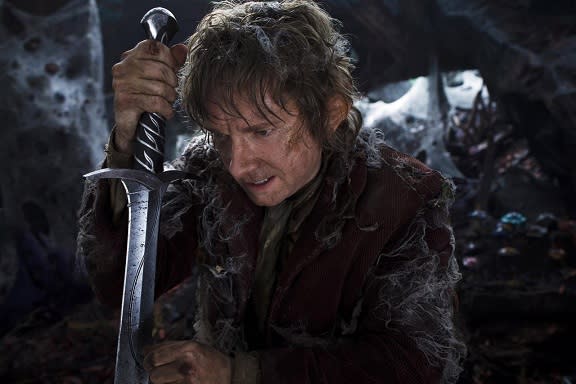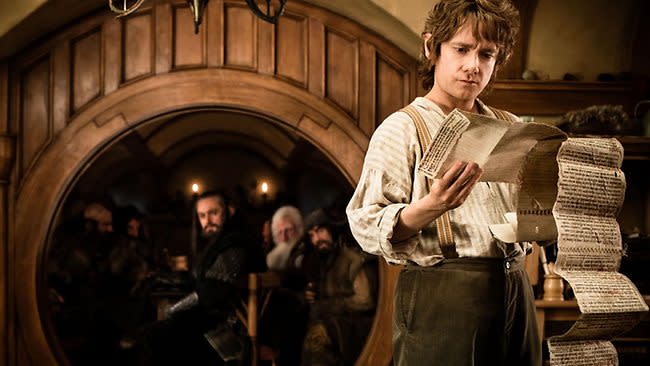'The Hobbit': What Critics Think
"The Hobbit: An Unexpected Journey" stampedes into theaters this weekend carrying with it the hopes of moviegoers that Peter Jackson can pull off the incredible: conjuring up the same Middle-Earth magic he dusted over "The Lord of the Rings."
Early reviews for his latest adaptation of J.R.R. Tolkien's fantasies were solid, though not rhapsodic. Many top critics praised Jackson's command of spectacle, but decried the film's three-hour running time.
They also largely hated his experiment with higher frame rates -- the director shot the film at 48 frames per second, double the standard speed, in an attempt to make the film's 3D seem crisper and more realistic. But reviewers like Slate's Dana Stevens wished he had stuck with the tried and true.
Also read: 'The Hobbit' at 48 Frames - Hey, What Happened to Middle-Earth?
With a respectable 68 percent "fresh" rating on critics aggregator Rotten Tomatoes, the film won't be weighed down by bad reviews as it prepares to dominate the holiday box office. Still, there's no denying that critics were far less enchanted by "The Hobbit" cornucopia of dwarves, goblins and wizards than they were by "The Lord of the Rings." Each film in that trilogy scored a Rotten Tomatoes "fresh" ranking in the 90 percent range.
In the New York Post, Lou Lumenick said "The Hobbit" could not match the grandeur of Jackson's first trio of films. He found much to enjoy about this treasure hunt, however. In particular, he credited Martin Freeman, best known for playing a love-stuck grunt on "The Office," with enlivening the character of Bilbo Baggins.
Also read: Why 'The Hobbit' Will Be Biggest Tolkien Tale Ever at the Box Office
The enterprise gave him hope for Jackson's two other proposed films. He wrote, "the first one, for all its indulgences, is far superior to another much-hyped prequel -- George Lucas' 'Star Wars: The Phantom Menace.'''
Joe Morgenstern of the Wall Street Journal said the film could have benefited from more evidence of the editor's art. But he said despite its length, there are enough visual pleasures to justify the price of admission.
"What needs resaying is that the good stuff in 'The Hobbit' is amazingly good," Morgenstern wrote. "And mainly animated, from the motion-capture magic of Andy Serkis's Gollum (you can see the little monster's twisted mind and constipated brain churning away in the marvelous riddle game) to the depths of the goblins' tunnels, where the proscenium frame—or floating box, in the 3-D version—teems with life forms previously unimagined and hitherto unimaginable."
Anthony Lane gave a more guarded endorsement. Writing in the New Yorker, he said the film was flabby and rife with Jackson's narrative indulgences. That's not a complete surprise, given that "The Lord of the Rings" trilogy caused collective bladder strain among global moviegoers with its hesitance to roll the end credits.
Still, Lane credited the filmmaker for his sincere ambition to capture the sparkle in Tolkien's story.
"'All good stories deserve embellishment,' Gandalf says to Bilbo before they set off, and one has to ask whether the weight of embellishment, on this occasion, makes the journey drag, and why it leaves us more astounded than moved," Lane wrote. "And yet, on balance, honor has been done to Tolkien, not least in the famous riddle game between Bilbo and Gollum, and some of the exploits to come -- dwarf-wrapping spiders, a battle of five armies, and the man who turns into a bear -- will surely lighten the load. As Bilbo says, nearing the end of the book, 'Roads go ever ever on.' Tell me about it."
For David Edelstein, the prospect of two more "Hobbit" films sounds about as appealing as a getaway to Mordor. The New York magazine critic slammed the first film's use of higher frame rates, complaining that it must "be seen to be disbelieved." What's good for a nature documentary, when it comes to the heightened look of film at higher speeds of projection, does not appear to work for a mythological adventure, he says.
"The immediacy of the actors is startling, but the background is weirdly foreshortened, the fakeness of the sets and makeup an endless distraction," Edelstein wrote of the technology. "Staginess does nothing for a fantasy-film epic. The dislocation caused me to miss great gobs of exposition in the first half-hour, which is all exposition, the grandeur of the 'Lord of the Rings' trilogy having been replaced by something that resembles tatty summer-stock theater."
Also left unimpressed by the higher frame rates was Slate's Dana Stevens. In an out-and-out pan, Stevens said that if 48 frames is the future of film, "The Hobbit" will be a "failed experiment" in that technological revolution. She found Jackson's use on the frame rates completely distracting. She also said the choice made it difficult for her to get caught up in the film.
"The best way I can think to describe the quality of the 48fps image in 'The Hobbit' is this: It looks like an '80s-era home video shot by someone who happened to be standing around on set while 'The Hobbit' was being filmed," Stevens wrote. "(Other visual analogues scribbled down in my screening notes include Teletubbies and daytime soap operas.)"
If Stevens watched "The Hobbit" unspool and thought of Teletubbies, the big thing that came to mind for Michael Philips was avarice. The Chicago Tribune critic said he suspected that the decision to turn Tolkien's relatively meager novel into a three-part epic was motivated by profits rather than slavish devotion to the text.
"When, in Jackson's film, someone describes a character's 'love of gold' as having become 'too fierce,' you wonder if the warning might apply to 'The Hobbit' in other ways," Phillips wrote.
Related Articles:
'The Hobbit' at 48 Frames - Hey, What Happened to Middle-Earth?
Why 'The Hobbit' Will Be Biggest Tolkien Tale Ever at the Box Office


